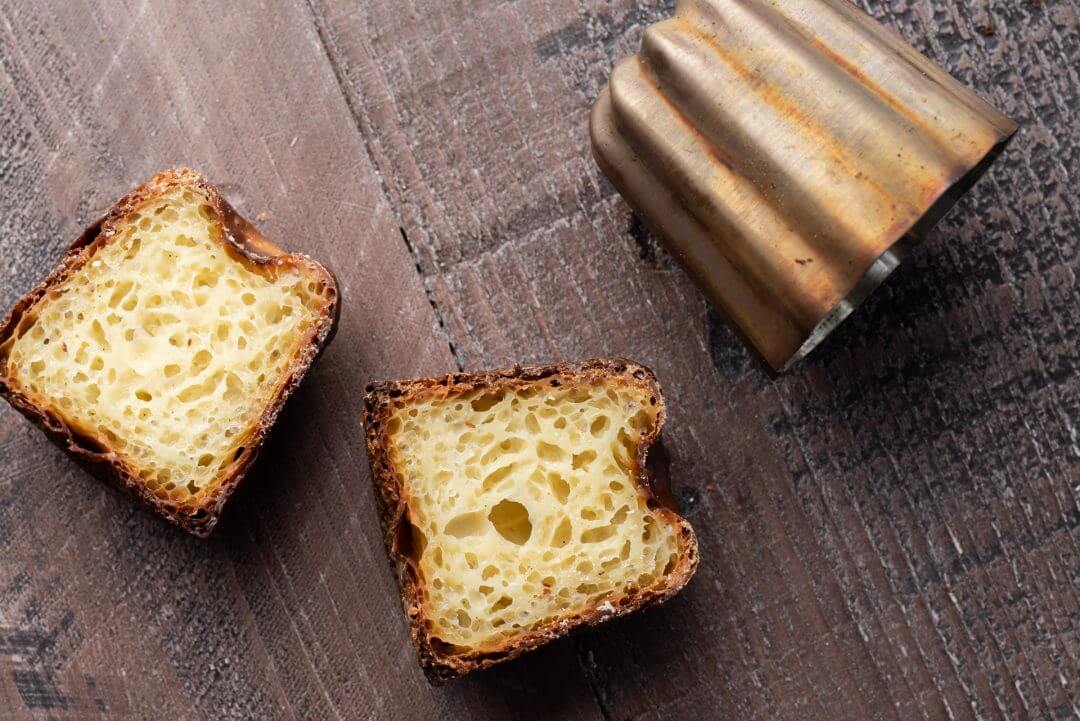This recipe isn’t about bread or sourdough starters, and at first glance, it might seem out of place on a website revolving around natural fermentation—seeing as there’s, gasp!, no fermentation at all—but read on and I know you’ll see the fit. A canelé is a small French pastry containing a mix of vanilla, rum, egg, butter, sugar, and flour. They’re quite challenging to make, requiring patience, practice, attentiveness, and perseverance. But the result? A small treat with a deeply caramelized shell and a soft, custard-like interior. The enticing look of these little pastries plays all too well to seduce, and their aromatic mix of burnt sugar, rum, and vanilla seals the deal. With interest piqued, questions ensue from those unfamiliar, and after trying, a steadfast disciple is born. In other words, when you make them, be sure to make extras.
The history of the canelé (also known as the cannelé, canale, cannelé de Bordelais, and canelé de Bordeaux) is conflicted. There are several origin stories, all of which sound perfectly plausible, but as is commonly the case, hard to verify. You might spot similarities with other French pastries as caramelized sugar with eggs and butter will never steer you wrong, but the ingenious thing about these is how the ultra-conductive copper molds impart intense heat on the thinnest outer layer of the batter. This creates a super crunchy shell with extreme contrast between the shell and the pudding-like interior.

To reiterate, these canelé don’t require any fermentation whatsoever. However, much like baking bread they do require precise measurement, attention to process, and arguably the most important factor: careful oven management. To make these pastries you essentially mix up a batter a few days before you want them ready, let the batter rest a few days in the fridge, then pour it into the copper molds after they’ve been seasoned with beeswax (to make them nonstick). Finally, bake them until dark, very dark.
I was first inspired to make these after reading the wonderful Tivoli Road Baker (highly recommended), whose recipe got me started down the rabbit hole of making canelé in my home kitchen. After countless attempts, I’ve finally arrived on a ratio of ingredients and a process that works very well for the home baker. Keep in mind that canelé are similar to bread in that they won’t be exactly the same each time. In fact, just like many products made by hand, they vary slightly from bake to bake — which is part of the charm. Each a little different in their own way, which is the right way.
I have to warn you: this is a long post with lots of information, but if you’re like me, you’ll find these are absolutely worth the effort. And, as is true with baking bread for me, it’s the challenge that makes them all the more rewarding. I’ve heard it said that panettone is the Mt. Everest of baking, well I think these might be the Mt. Everest of pastry baking.
Ok, are you ready for a challenge?
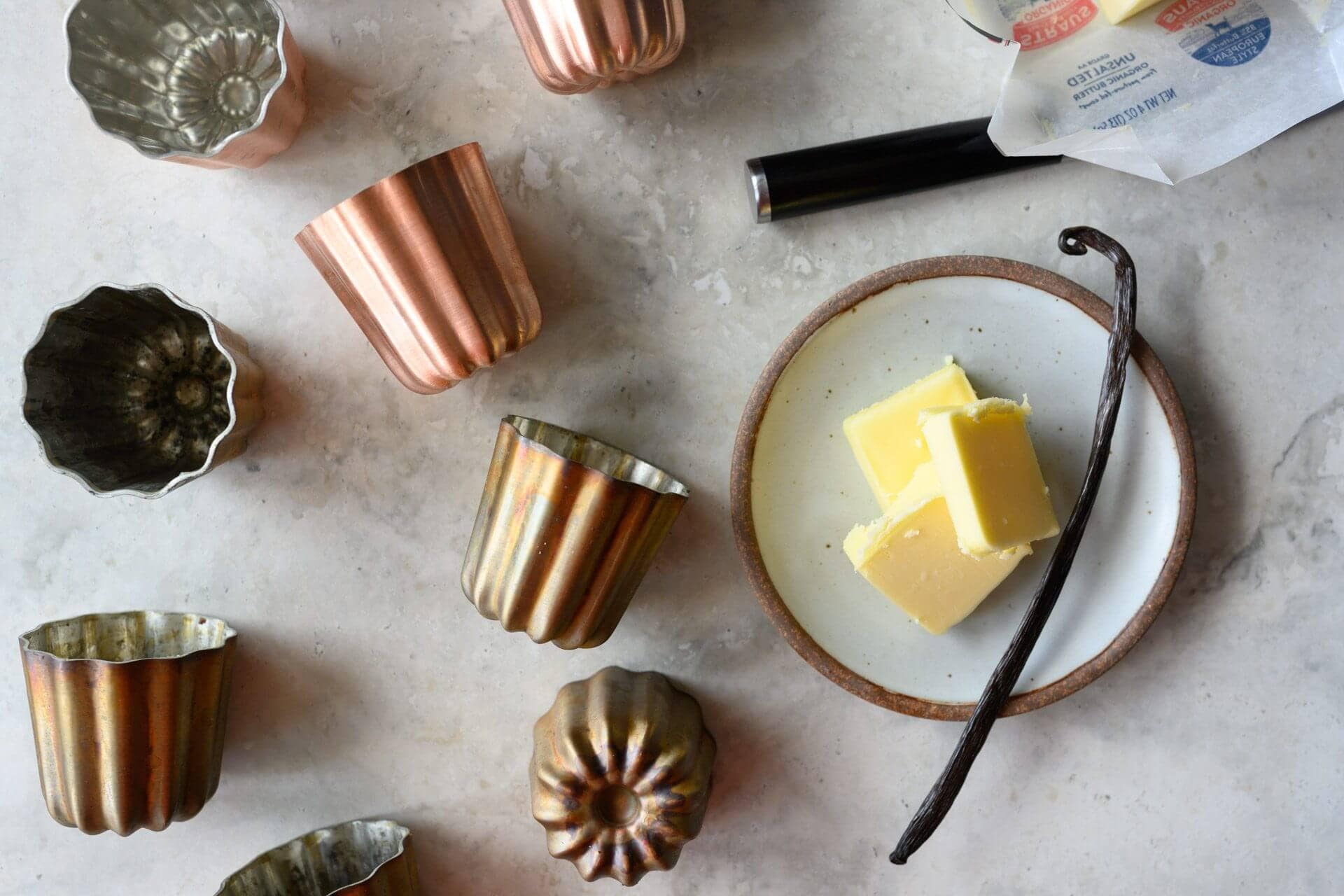
Useful Tools
First, let’s go over a few tools I highly recommend: heavy-duty oven gloves, sturdy aluminum baking sheets, and a Baking Steel.
Oven Gloves
Using thick, oven-safe gloves on each hand makes dealing with the baking sheet and smoking hot canelé molds a lot easier. This is especially true when you’re reaching into the oven to check when they are done.
Baking Sheets
I’ve tried using aluminum baking sheets of various sizes and found the quarter and half sheets to work the best. If you’re doing a small batch of canelé, say 5 or so, then I like to use quarter sheets that fit completely on top of my Baking Steel. If using a half sheet, be sure you don’t have any canelé molds not directly over the Baking Steel below the sheet.
Be sure your trays are of high quality. If the tray is thin it may warp right when you place it on the smoking hot Baking Steel — they won’t be ruined, but they’ll cause the batter to rise unevenly. Using a good quality quarter baking sheet seems to help alleviate this warping issue, and the entire sheet fits perfectly on my Baking Steel.
Baking Steel
A while back I switch from baking the canelé straight on a baking rack to a baking stone with a huge improvement in the final product. Eventually, I changed to using my Baking Steel and further improvements were immediately discovered.
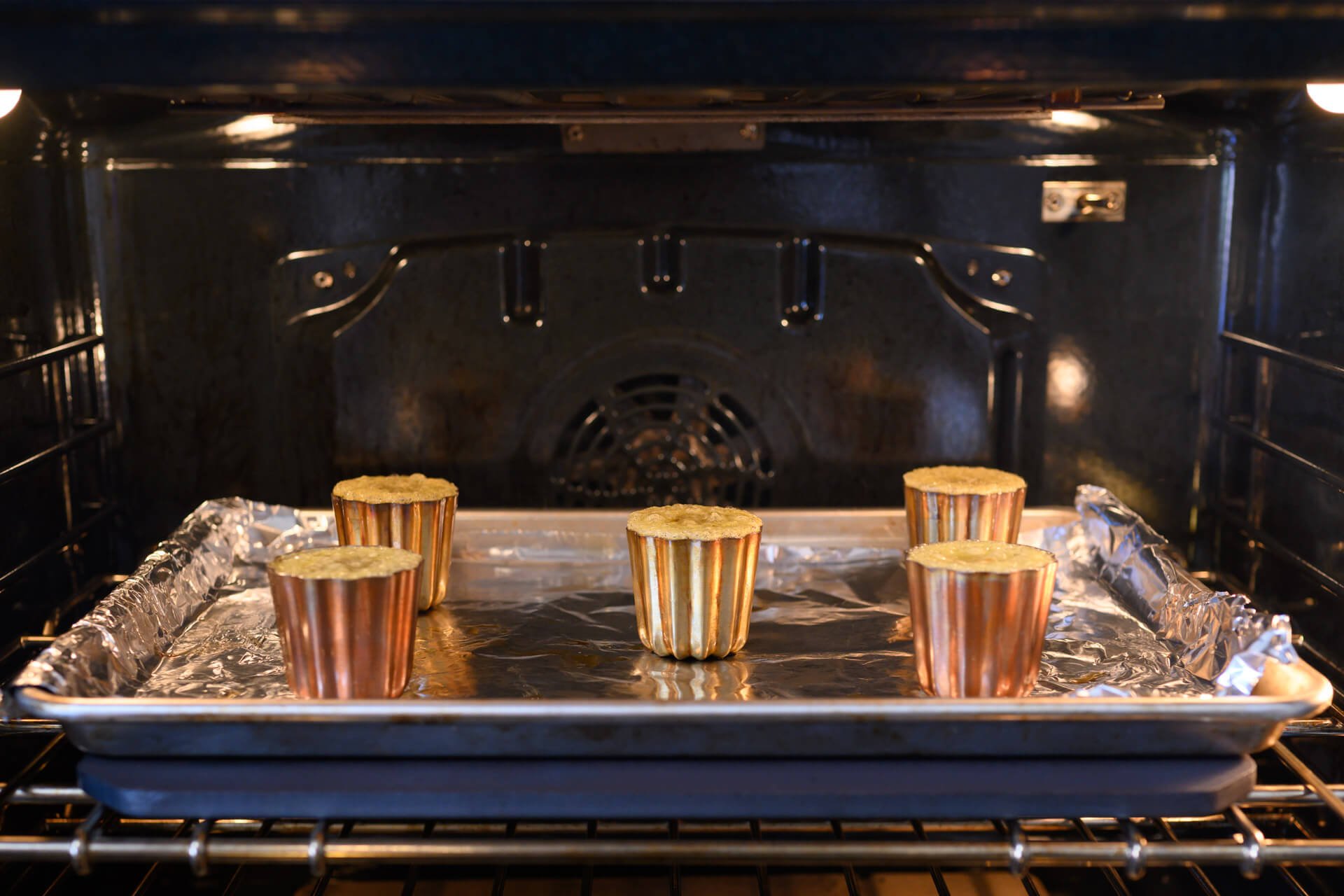
Because the steel gets so hot and efficiently transfers its “stored” heat to whatever is placed on top, it more effectively shocks the batter into baking faster. Using the Baking Steel also helped to alleviate the common issue where the top of the canelé is white (“cul blanc,” as they say) and the rest of the crust is dark.
Batter Storage
After making the batter it needs to rest for at least 48 hours (or up to 4 days) before using. I like to keep the batter in 1-quart Cambro containers (seen below) in the fridge during this rest. The containers conveniently hold all the batter and have a tight-fitting lid. On bake day, I gently whisk the batter to reincorporate, then pour it out into a measuring cup with a spout to fill the molds.
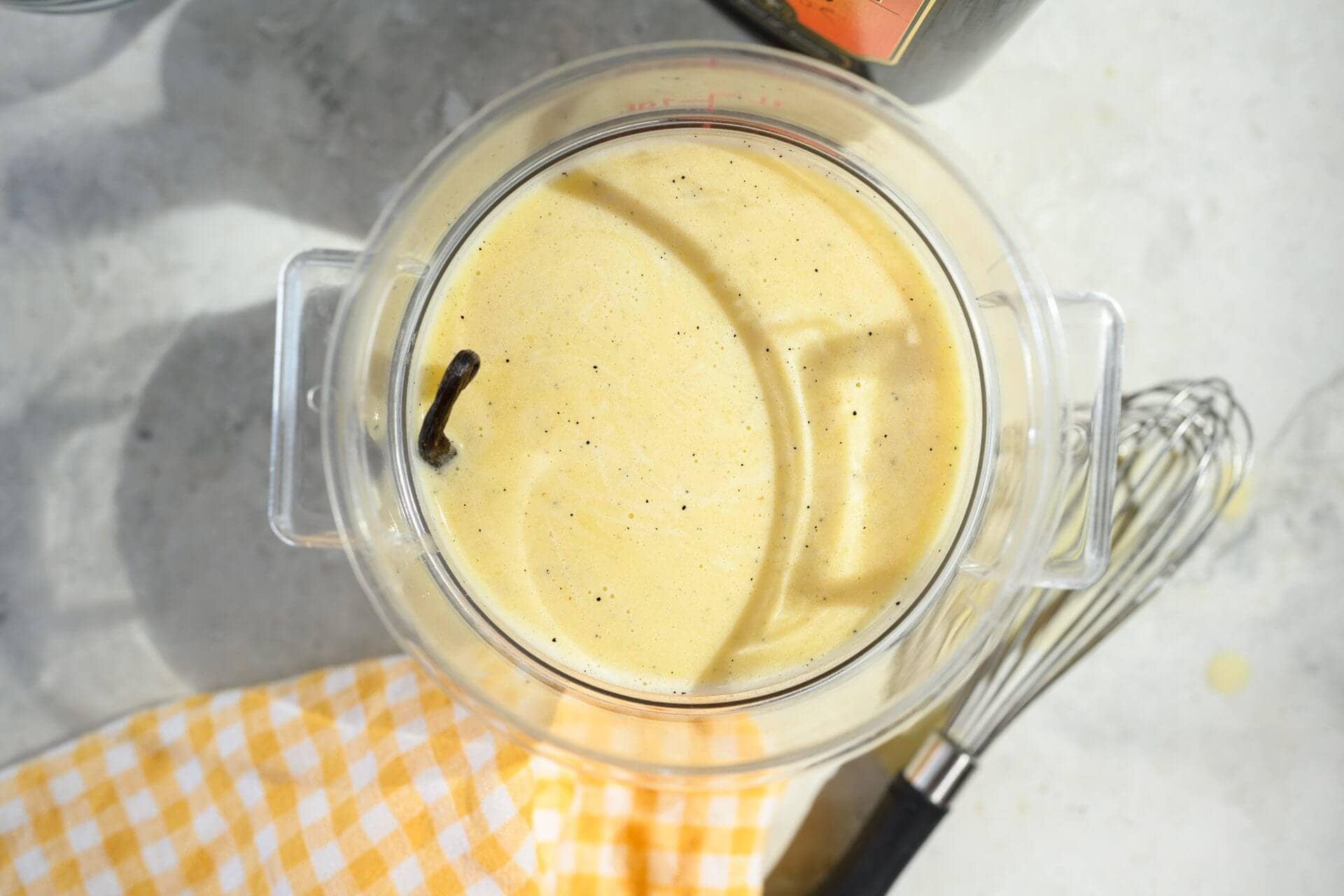
Canelé Molds and Seasoning
Copper Canelé Molds
Many argue that proper canelé should be made in tin-lined copper molds. I haven’t tried using anything other than copper so I can’t comment on other options (such as silicone canelé molds), but I do know the tinned Mauviel 2-inch (5.5 cm) canelé molds work incredibly well. When properly seasoned (more on this below) I have yet to have any sticking issues. They produce canelé with a deeply caramelized crust and a soft, tender interior — just what we want.
As recommended by the manufacturer, avoid cleaning the molds with any harsh abrasive or anything metal. After using them, I simply wipe them down with paper towels to ensure any burned-on crust is removed. I never wash them.
First-Time Seasoning
Tinned copper canelé molds require seasoning before their first use (like you would season carbon steel or a cast iron pan). It’s a simple process and only needs to be performed once, after which you’ll only have to lightly coat the interior of the mold with liquified beeswax.
I like to use organic, 100% odor-free beeswax to line my molds. I find beeswax works incredibly well at preventing sticking and also adds a touch of flavor to the final canelé. Some bakers prefer a mix of 50% beeswax and 50% clarified butter — this is another option.
To begin the initial seasoning, preheat your oven to 350°F (175°C).
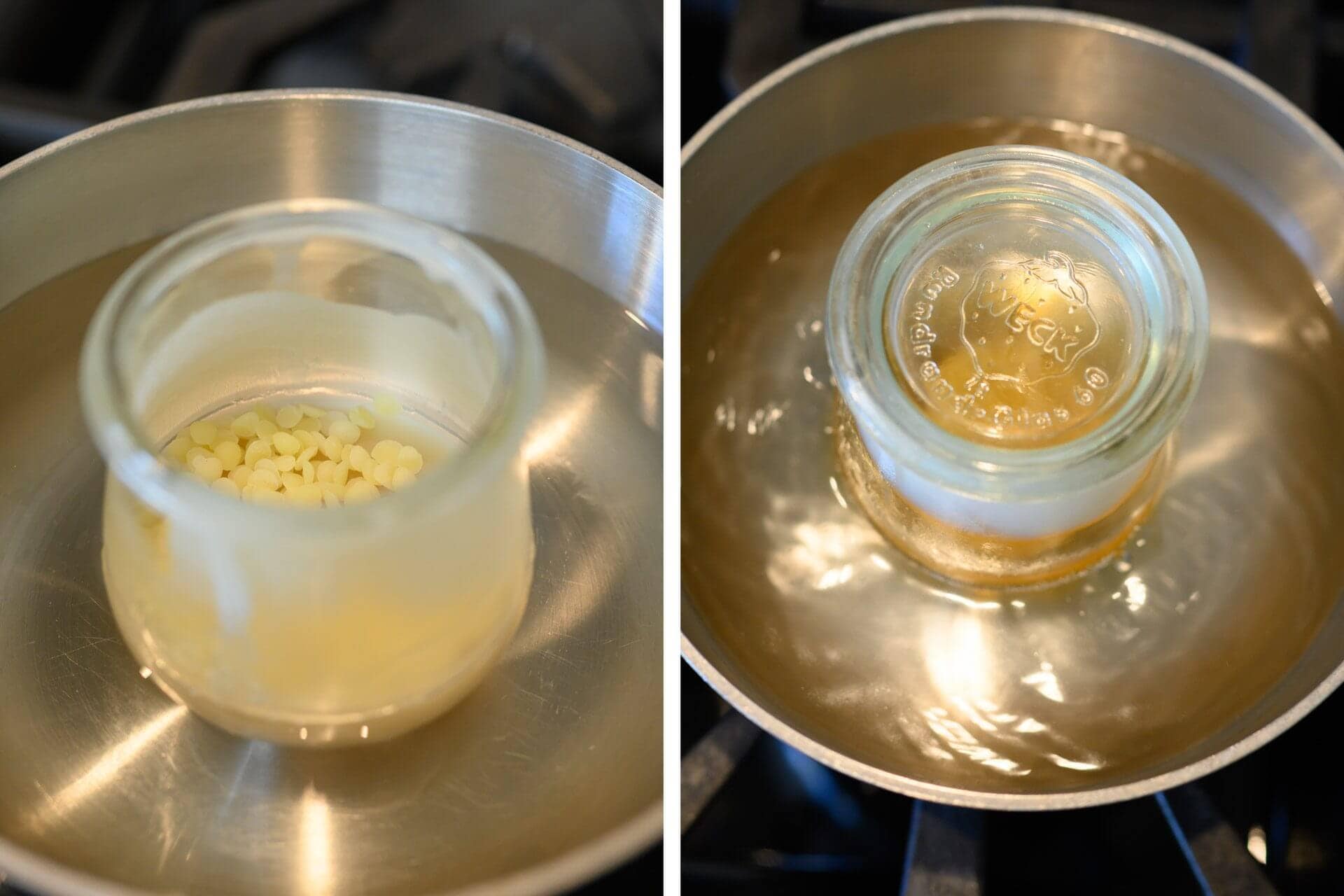
While your oven is preheating, melt your beeswax. Because I buy beeswax in pellets, I simply add the pellets to a glass jar (I use these Weck jars to melt and then store the wax for future use) and place the jar inside a saucepan with just-simmering water (do not excessively heat the wax) to liquify. Turn the stove to low to keep the wax liquid.
Next to your oven, place a piece of tin foil or parchment paper underneath a wire cooling rack to catch any excess wax drippings. Additionally, line a half or quarter baking sheet with tin foil and place the molds on the sheet, open side up. Once your oven is preheated, place the sheet with molds in the oven and bake for 2 minutes.
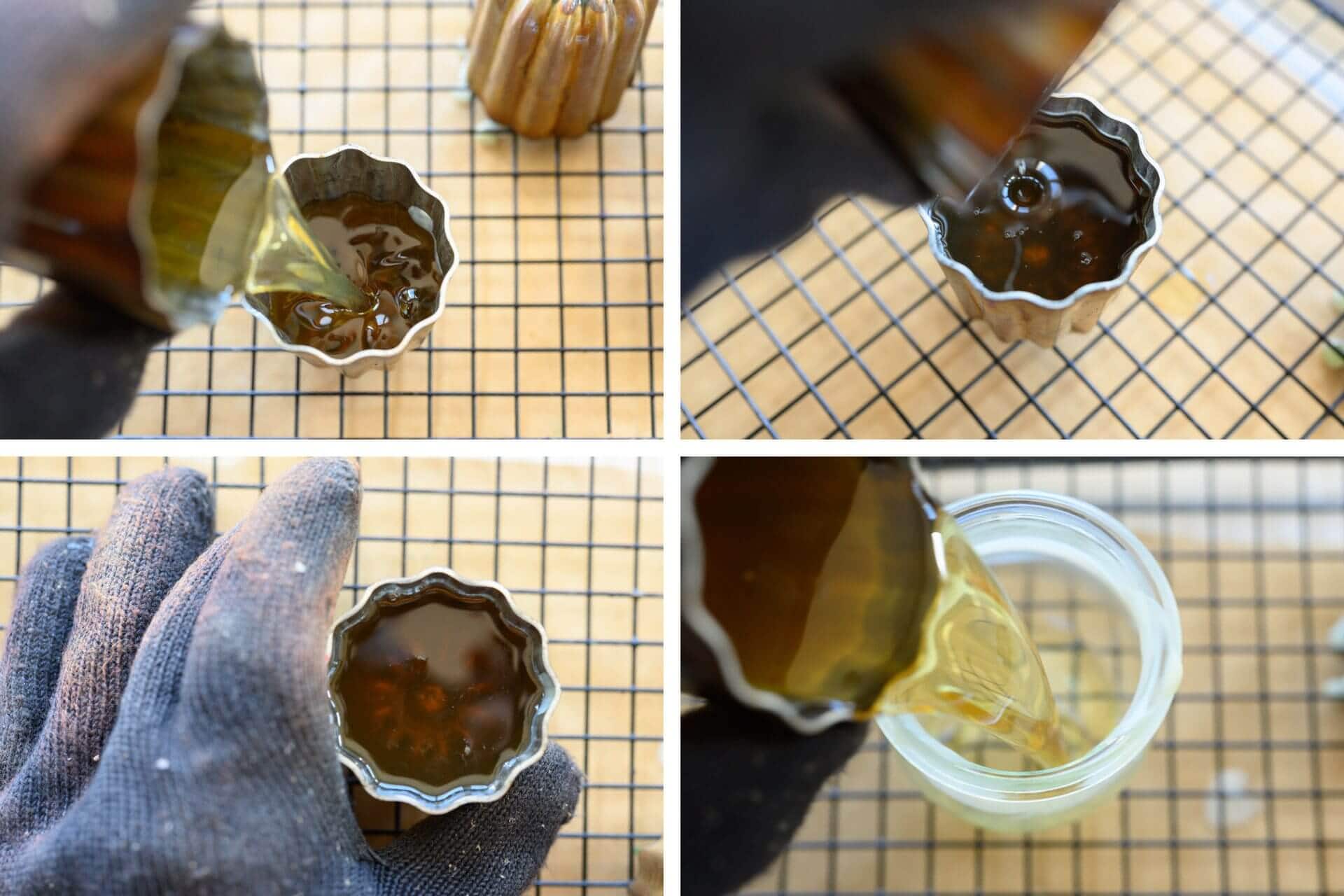
After 2 minutes, remove the sheet from the oven. While wearing oven-safe gloves on each hand, carefully pour the melted beeswax into one of the molds so it fills almost to the top (top-left in the photo above). Swirl the beeswax around slowly to coat, and pour the beeswax to the next mold (top-right, above). Place the seasoned mold open-side-down on a baking rack so the excess wax drips out to the tin foil. Continue pouring the wax from one mold to the next until all have been processed, then pour the remaining wax into the glass jar originally used for melting (bottom-right, above). You can store the wax, cooled, in the jar for the next batch of canelé.
Now, place the molds back on the baking sheet (without cooling rack but on top of tin foil) open-side-up and bake at 350°F (175°C) for 10 minutes. After this time, remove the sheet and pour out any wax that may have pooled at the bottom of the mold. Then, let the molds cool. Repeat the entire seasoning process one more time.
Now your molds have undergone their initial seasoning and this double-seasoning process won’t need to be performed again. The first time you bake these you won’t have to quick-season them, but every time after you will.
Important Tips Before Beginning
I find most of the problems I encountered when making these early on were due to really small issues that added up to bigger problems. This section has some of the tips and tricks I’ve found to help make these canelé a higher quality, more consistently. Don’t skip through this section!
Measuring Ingredients
As with sourdough bread, I prefer to measure out these ingredients by weight for accuracy. When dealing with the whole eggs: use a cracked eggshell to remove some of the white if it’s over the called for amount. And similarly, for the egg yolks I use the shell to drain the white, then pierce the yolk in the shell and pour out just enough to make the required amount.
Oven and Heat Management
Arguably the most important factor when making these is heat management. The first section of the bake requires intense heat to sort of “shock” the batter and force it to start forming a skin, or shell (this is why I like using a Baking Steel). If your oven is too cool when baking you’ll end up with uneven coloring across the finished result.
I find my oven works best when I’m making 5 of these at a time. I typically make 5 one day and then save the rest for another. A side benefit to only baking a few at a time: I prevent myself from eating two or three right once they cool. The guilt of eating almost an entire batch is too much to bear. When I do all 10 at once it works, but the batter rises up out of the mold a little more. This is because the oven temperature drops a little too much with all of them in at once. And speaking of batter rising from the mold…
Batter Rising from Mold
If at any point you see the batter start to rise up too high above the edge of the mold during baking, don’t panic. As long as this isn’t excessive, by the end of the total bake time, most of the rise will have collapsed into the mold. In fact, a little rise out of the molds is expected and just fine.
I’ve found rising like this is usually due to insufficient oven heat (and also could be an issue with over-waxed molds, creating too much heat insulation). To alleviate, you could try increasing the temperature of the oven next time.
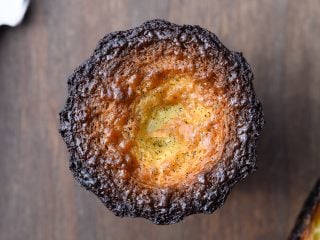
Pale, Dented Bottoms
It’s normal for the bottom of the canelé to be a little pale and not fully brown (see image right). Additionally, I’ve found sometimes they cave in ever so slightly as liquid pools there when baking. My feeling is, a little of this is ok, as long as it doesn’t get excessive.
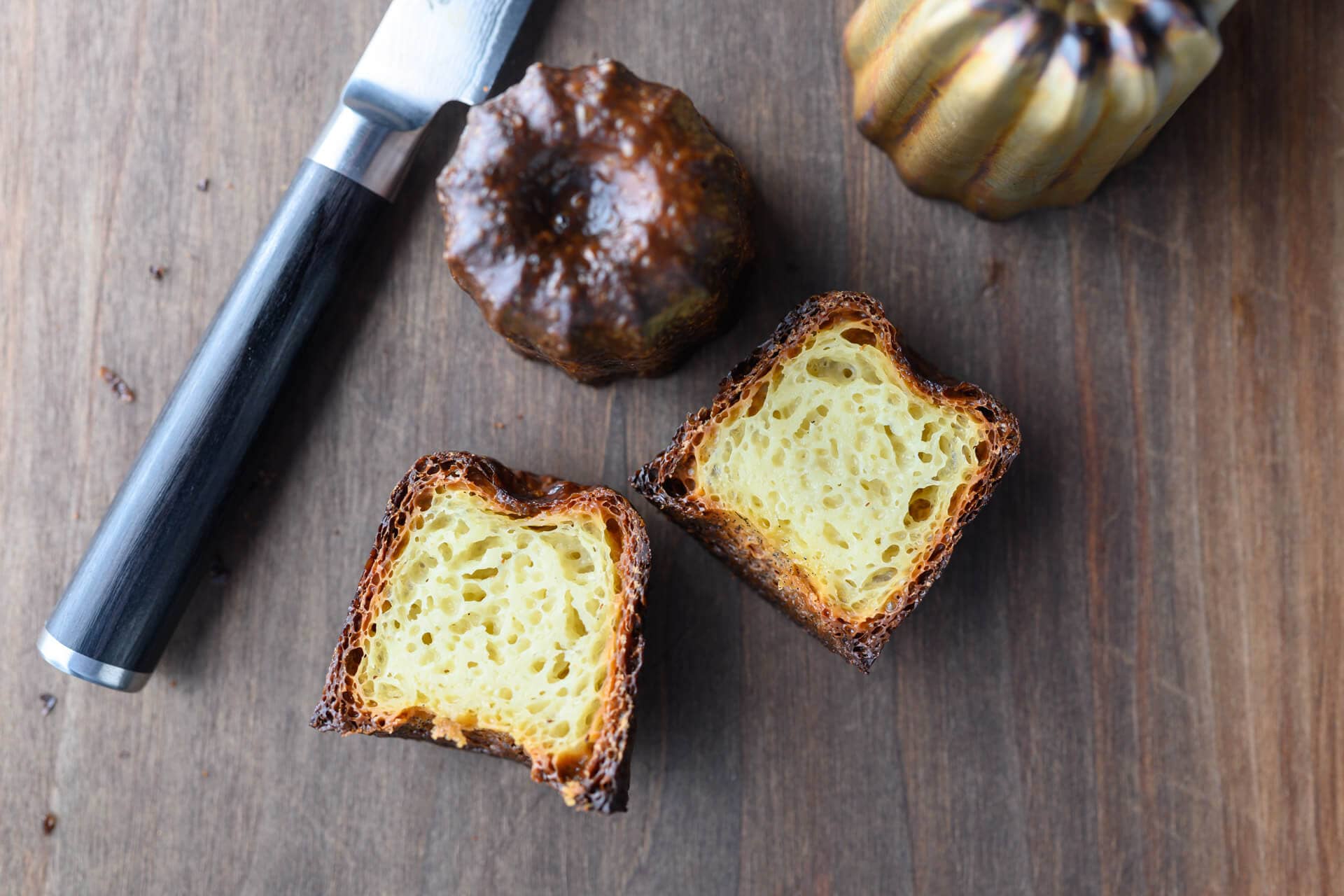
Canelé Recipe
Vitals
| Yield | Ten to twelve 75 g canelé (pre-bake). I usually get 11 or 12 in my 2″ molds. This depends on how diligent you are about wiping out every container thoroughly and salvaging every bit of batter. If you only have five molds, you can make one half one day and the rest another. |
Batter
| Weight | Ingredient |
|---|---|
| 475g | Whole milk |
| 200g | Confectioner’s (powdered) sugar (it’s important to use powdered sugar as it has some corn starch, which adds to the texture.) |
| 95g | All-purpose flour (I prefer lower-protein flour; even pastry flour would work well) |
| 85g (about 2 medium) | Whole eggs |
| 35g (about 2.5 medium yolks) | Egg yolks |
| 45g | European style butter, unsalted (I like Straus, 85% butterfat) |
| 20g | Rum (I like Bacardi Reserva 8-year). The amount of rum is rather low compared to other recipes, but I like more of a hint. |
| 1/4 teaspoon | Sea salt |
| 1 | Vanilla bean |
| As needed | Food grade, organic beeswax |
Method
Day One—Prepare Canelé Batter
Add the milk and the butter to a saucepan and bring up to 185°F (85°C), stirring occasionally. The butter will have melted, and the mixture will start to foam slightly at the edges. Remove from the heat and transfer to a medium-sized bowl or large glass pouring vessel. Scrape the seeds from the vanilla bean and add both the seeds and pod to the warm mixture. Let this all cool while you prepare the rest of the ingredients.
In a large bowl, sift together the flour, confectioner’s sugar, and salt. Note that it’s very important to sift these together as confectioner’s sugar tends to clump.
Add the whole eggs and egg yolks to a plastic cup or narrow pitcher. Blend together using an immersion blender (this helps blend the eggs thoroughly without incorporating air). Alternatively, you can use a whisk to blend them together, just avoid working in too much air.
At this point, be sure the milk mixture is mostly cool, if not, place it in the fridge for 15 minutes, then proceed. Remove, but reserve, the vanilla bean from the cooled milk mixture and slowly stream in the egg mixture while stirring. Then add the rum.
Pour the milk/egg/rum mixture batter through a fine-meshed sieve over the dry ingredients. Gently combine everything with a whisk (do not over mix or incorporate air) until combined and no lumps remain.
Pass the entire mixture once more through a fine-meshed sieve into a storage container with a lid (again, I like these 1-quart Cambro). Add the reserved empty vanilla bean to the container, cover, and place in the fridge for 48 hours.
Day Two—Rest Canelé Batter
Let the batter rest for 48 hours before baking the canelé. You could use them after 24 hours, but I’ve found it best to wait a full 48 hours for full flavor and a better texture.
Day Three (or up to five)—Bake Canelé
Quick-Season Copper Molds
This is a quick-seasoning step that applies a thin layer of beeswax to the mold before baking to ensure the canelé remove cleanly.
Make sure to use copper molds that have already been fully seasoned (see First-time Seasoning section, above).
Follow the steps in the First-time Seasoning section but perform this only a single time. After you do the 10-minute bake with wax, be sure to pour out any wax that may have pooled at the bottom of the mold (otherwise the tops of the canelé will take forever to bake fully). Once the molds have cooled a bit, place them on a plate and into the freezer for 30 minutes.
Do ahead: this quick-seasoning can be done any time with all the molds. After they’ve cooled, place them in a covered container in the freezer and store there until you’re ready to bake the canelé.
Bake
Place a Baking Steel (or, if you don’t have one, a baking stone, although I find the steel to work best) on a rack in the middle of your oven. While the molds are in the freezer, preheat oven to 450°F (230°C) for 1 hour. Yes, it’s necessary to preheat this long to ensure the Baking Steel/stone is thoroughly preheated.
Line a half or quarter baking sheet with tin foil and remove the rested canelé batter from the fridge. Whisk the batter (but don’t incorporate any air) to blend together the ingredients so they form a homogenous mixture (this might take 1-2 minutes). Transfer the batter to a measuring cup with a spout.
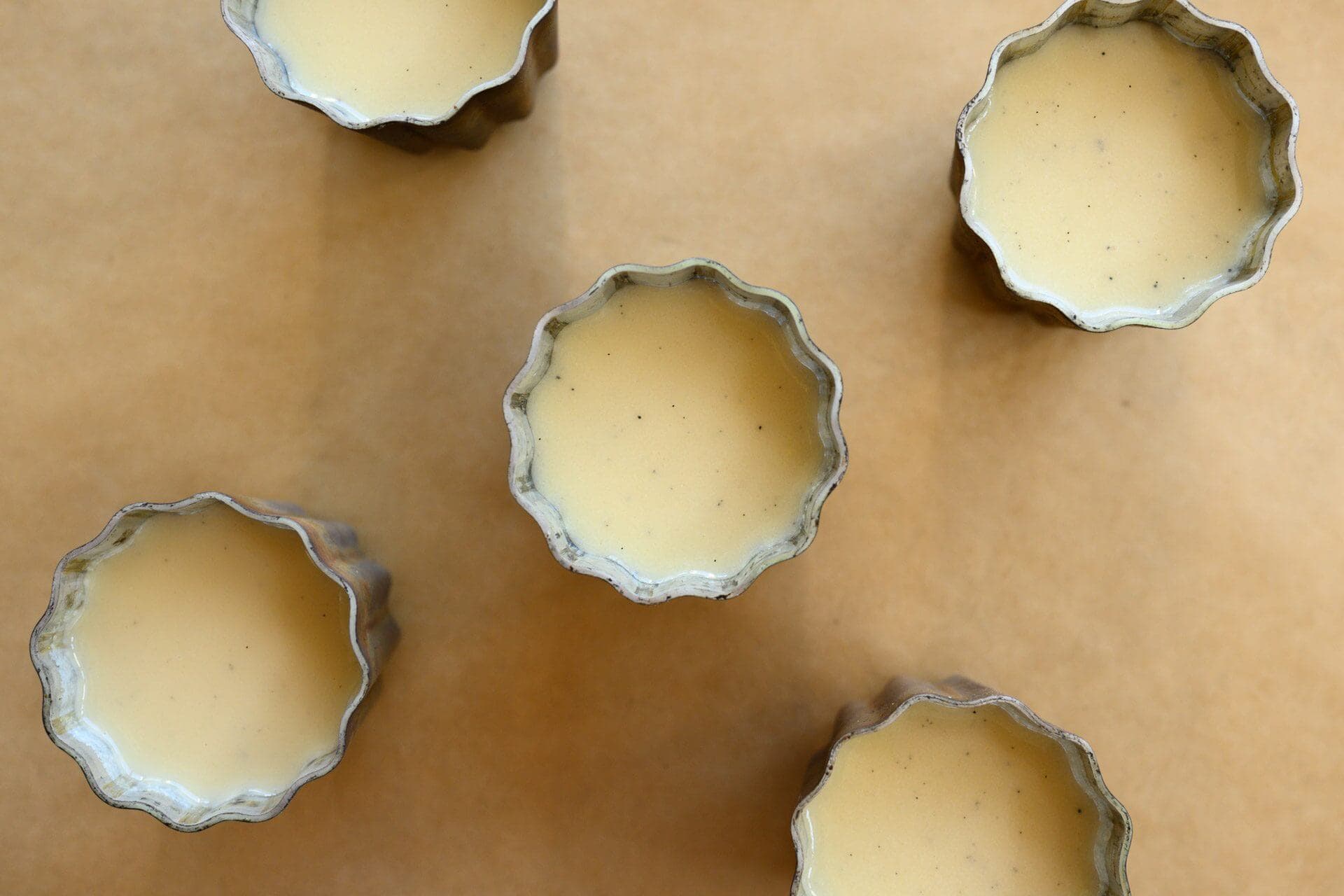
this is the applied beeswax seasoning to make them nonstick.
Pour 75g of batter (about 1 cm from the rim) into each frozen mold and place it on the prepared baking sheet with foil. Space them evenly on the sheet and place the sheet on the Baking Steel in the oven. Be sure the molds are direcly over the Baking Steel in the oven.
Bake for 15 minutes at 450°F (230°C).
After 15 minutes, quickly open the oven door and rotate the baking sheet 180°. Then, turn the oven down to 350°F (175°C) and bake for 50-60 minutes.
Keep an eye on them in the last 10 minutes of the bake time, these can quickly go from perfect to burned. In the image below, you can see how the crust looks when they went just a little too far in the oven (only 4 minutes more caused this!). They tasted fantastic except for a hint of burnt carbon flavor (to me at least).
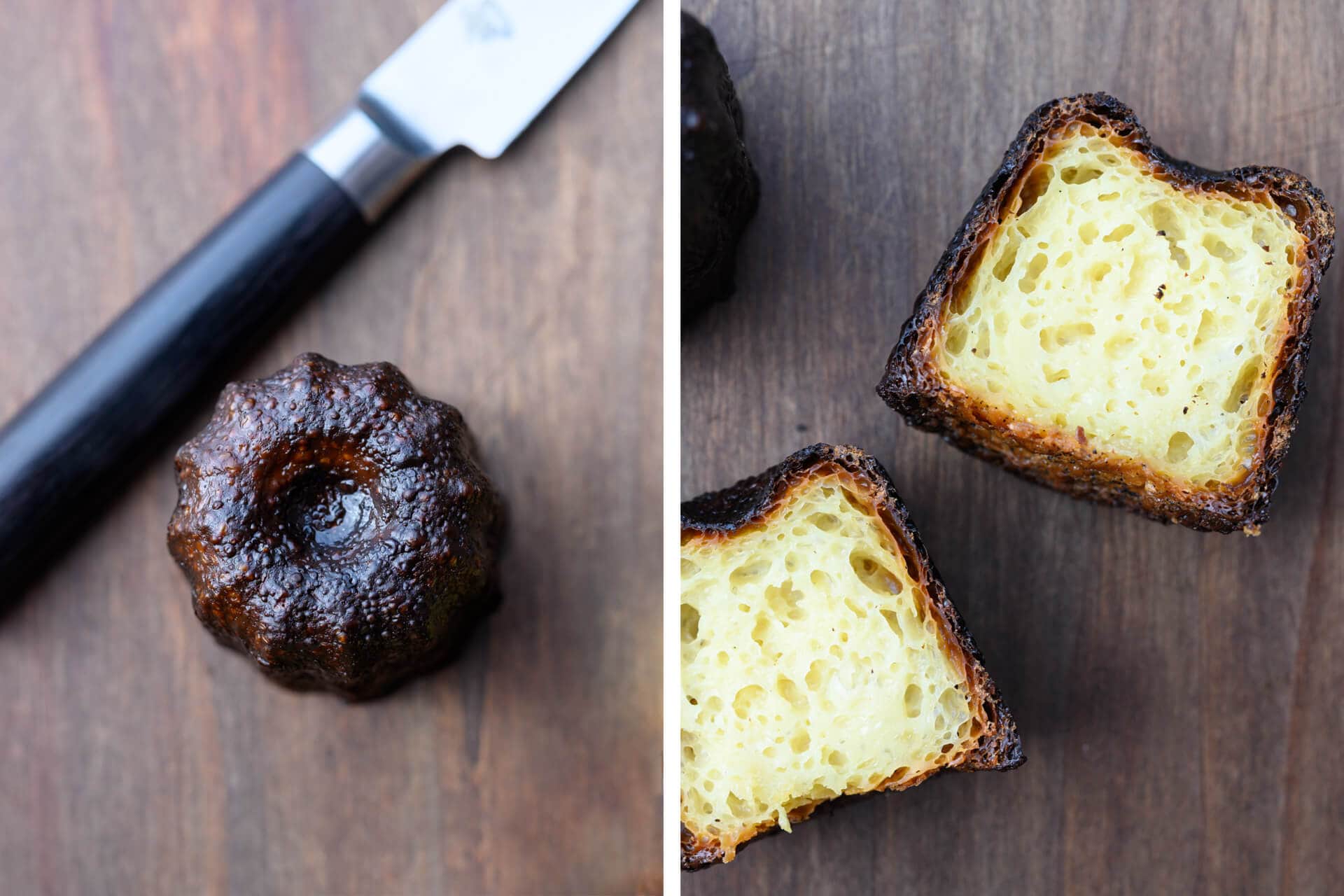
Some canelé will bake faster than others. Using gloves, check each canelé to see if it’s done by turning it out onto a cooling rack above a layer of tin foil on the counter. If the canelé is uniformly dark all over, it’s finished. If you find the top (the “crown”) is still pale-colored, or the color is not uniform, return it to the mold and place bake on the baking sheet in the oven. Check again in 5 minutes. As mentioned above, the bottom of each canelé will be a little pale in color compared to the sides and top. This is to be expected.
Keep an eye on the canelé in the last 10 minutes, these will quickly go from perfect to burned.
When all are finished, let the canelé cool on the wire rack for 45 minutes to 1 hour until hardened. They are best the day they’re made, but I found they can be blasted under the broiler for a minute or two and crisp up rather well the next day. Alternatively, you can bake half the batter one day and finish the rest the next.
When all are finished, let the molds cool and wipe them clean with a paper towel. Do not wash the copper molds.
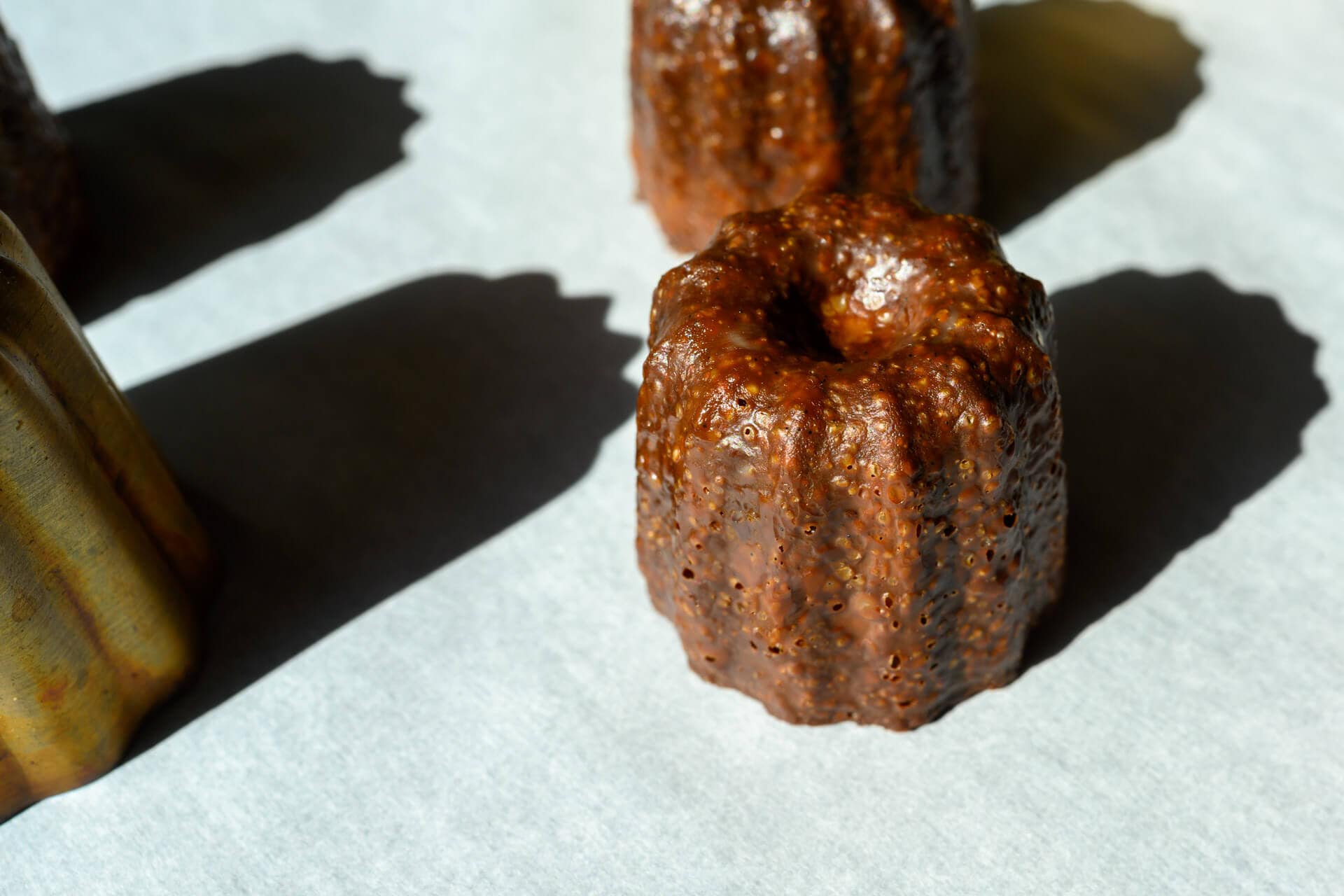
Conclusion
When you make an exquisite canelé, it’s one of the most satisfying baking pursuits. You achieve something that’s at the same time characterized by extreme delicacy and heavy substance. The opposition between these two is what brings these so much eating pleasure. And! The hint of vanilla and rum peek through the eggy, buttery, custard-like interior elevates the well-tuned concert of flavors to maximum satisfaction.
Yes, the molds are very expensive, the planning and attention to process require a concerted effort, and you’ll likely have some less-than-stellar results, but I’ll say it outright: the prize is worth the investment and the endeavor. A classic French pastry with a sublime flavor made right from a home oven—how satisfying.
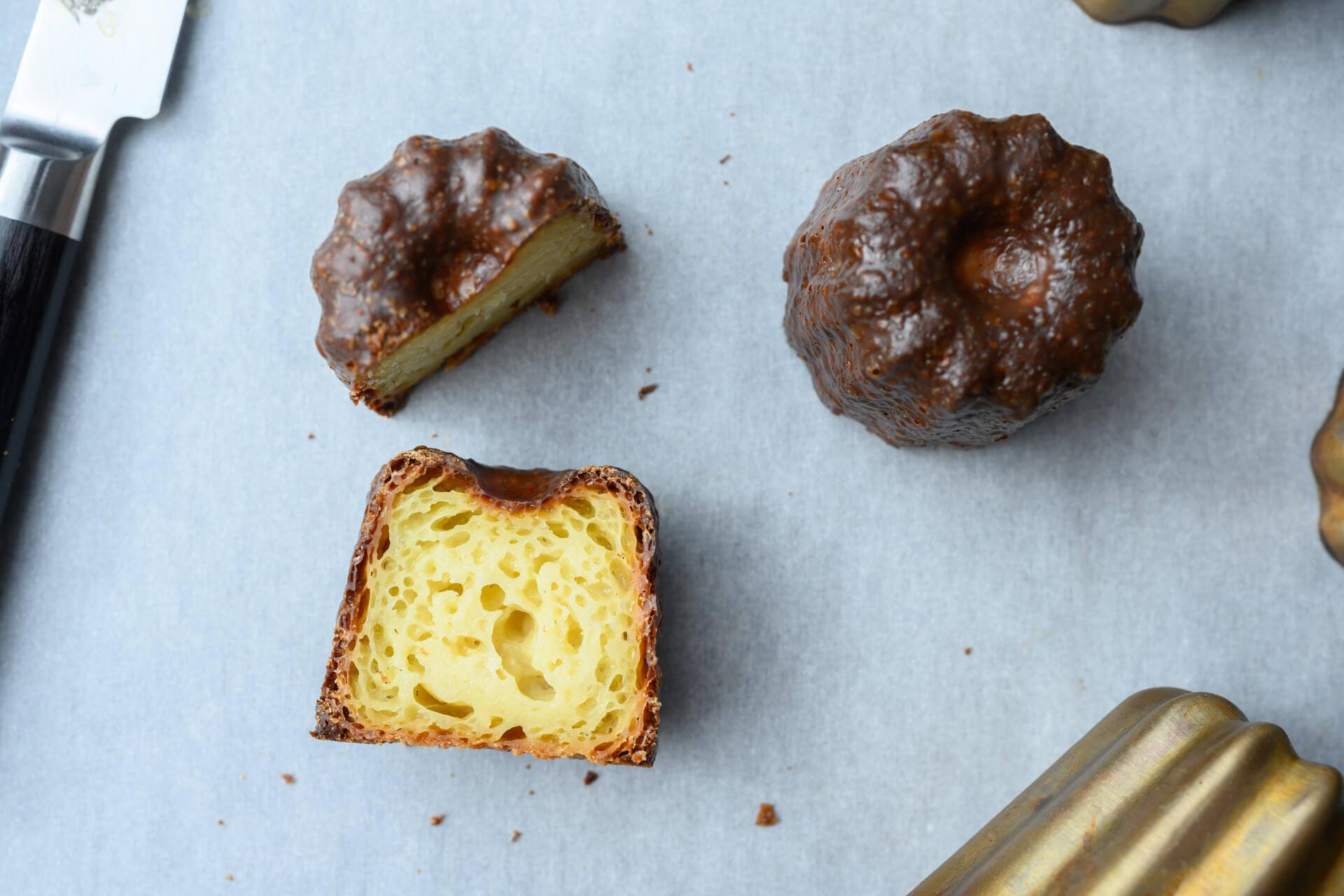
Well, there you have it, my treatise on making one of the most wonderful pastries I’ve ever eaten. I’ve been working on these—and this post—for a long, long time and I hope this helps you on your way to the land of canelé success. If you have any tips, pointers, or things you’ve tried to make these more consistent, I’d love to hear from you in the comments!
Happy baking and bon appétit!
Print
How to Make Canelé
- Author: Maurizio Leo
- Prep Time: 2 hours
- Cook Time: 75 minutes
- Total Time: 3 hours 15 minutes
- Yield: Twelve 75g canelé
- Cuisine: French
Description
A canelé is a small French pastry containing a mix of vanilla, rum, egg, butter, sugar, and flour. They’re quite challenging to make, requiring patience, practice, attentiveness, and perseverance. But the result? A small treat with a deeply caramelized shell and a soft, custard-like interior.
Ingredients
- 475g whole milk
- 200g confectioner’s sugar (powdered sugar)
- 95g all-purpose flour
- 85g (about 2 medium) eggs
- 35g egg yolks
- 45g European style butter, unsalted
- 20g rum
- 1/4 teaspoon sea salt
- 1 vanilla bean
- Food grade beeswax (as needed to season and line molds)
Instructions
- Day One (Prepare batter)
Add the milk and the butter to a saucepan and bring up to 185°F (85°C), stirring occasionally. Remove from the heat and transfer to a medium-sized bowl or large glass pouring vessel. Scrape the seeds from the vanilla bean and add both the seeds and pod to the warm mixture. Let this all cool while you prepare the rest of the ingredients.
In a large bowl, sift together the flour, confectioner’s sugar, and salt. Add the whole eggs and egg yolks to a narrow pitcher. Blend using an immersion blender.
At this point, be sure the milk mixture is mostly cool. Remove, but reserve, the vanilla bean from the cooled milk mixture and slowly stream in the egg mixture while stirring. Then add the rum. Pour the milk/egg/rum mixture batter through a fine-meshed sieve over the dry ingredients. Gently combine everything with a whisk (do not over mix or incorporate air) until combined, and no lumps remain. Pass the entire mixture once more through a fine-meshed sieve into a storage container with a lid. Add the reserved empty vanilla bean to the container, cover, and place in the fridge for 48 hours.
- Day Two (Rest batter)
Let the batter rest for 48 hours before baking the canelé. You could use them after 24 hours, but I’ve found it best to wait a full 48 hours for full flavor and a better texture. - Day Three (Quick-season copper molds)
This is a quick-seasoning step that applies a thin layer of beeswax to the mold before baking to ensure the canelé remove cleanly. Preheat your oven to 350°F (175°C).While your oven is preheating, melt your beeswax in a small saucepan over medium-low heat. Next to your oven, place a piece of tin foil or parchment paper underneath a wire cooling rack to catch any excess wax drippings. Additionally, line a half or quarter baking sheet with tin foil and place the molds on the sheet, open side up. Once your oven is preheated, place the sheet with molds in the oven and bake for 2 minutes.
After 2 minutes, remove the sheet from the oven. Carefully pour the melted beeswax into one of the molds, so it fills almost to the top. Swirl the beeswax around slowly, and pour the beeswax into the next mold. Place the seasoned mold open-side-down on a baking rack so the excess wax drips out to the tin foil. Continue pouring the wax from one mold to the next until all have been processed, then pour the remaining wax into the glass jar originally used for melting.
Next, place the molds back on the baking sheet (without cooling rack but on top of tin foil) open-side-up and bake at 350°F (175°C) for 10 minutes. After this time, remove the sheet and pour out any wax that may have pooled at the bottom of the mold. Then, let the molds cool. Place the molds into the freezer for at least 30 minutes until you’re ready to bake the canelé.
- Day Three (Bake)
Place a baking steel on a rack in the middle of your oven. While the molds are in the freezer, preheat the oven to 450°F (230°C) for 1 hour.
Line a half or quarter baking sheet with tin foil and remove the rested canelé batter from the fridge. Whisk the batter (but don’t incorporate any air) to form a homogenous mixture. Transfer the batter to a measuring cup with a spout. Pour 75g of batter (about 1 cm from the rim) into each frozen mold and place it on the prepared baking sheet with foil. Space them evenly on the sheet and place the sheet on the Baking Steel in the oven.
Bake for 15 minutes at 450°F (230°C).
After 15 minutes, quickly open the oven door and rotate the baking sheet 180°. Then, turn the oven down to 350°F (175°C) and bake for 50-60 minutes. Keep an eye on them in the last 10 minutes of the bake time; these can quickly go from perfect to burned.
Using gloves, check each canelé to see if it’s done by turning it out onto a cooling rack above a layer of tin foil on the counter. If the canelé is uniformly dark all over, it’s finished. If you find the top (the “crown”) is still pale-colored, or the color is not uniform, return it to the mold and place bake on the baking sheet in the oven. Check again in 5 minutes.
When all are finished, let the canelé cool on the wire rack for 45 minutes to 1 hour until hardened. They are best the day they’re made but reheat well with a minute under the oven broiler.
When all are finished, let the molds cool and wipe them clean with a paper towel. Do not wash the copper molds.
Notes
Be sure to season your canelé molds before their first use.
It’s best to let the batter rest for at least 48 hours after mixing (and this can be extended to up to 4 days).
Troubleshooting
Do I have to use copper molds to make canelé?
It’s hard to compete with the efficiency and effectiveness of copper. I haven’t tried silicone molds, so I can’t comment on how well they work, but for me, copper is the way to go.
Why do my canelé end up with a white top?
During seasoning, you might have too much beeswax pooling at the mold’s top (the crown). Be sure to let the wax drain out after you fill them by turning them over (so the open side is facing down) on a wire rack.
Additionally, it could be that they’re not done baking. Check the top of each one upon taking it out of the oven; if it’s not done, return to the oven for 5 minutes more. A Baking Steel/stone helps with this issue.
Why is the outside of my canelé nice and crispy but the inside hard (and not custardy)?
You’re likely baking these too long at too low of a temperature. Try increasing the temperature of the long portion of the bake by 25°F (4°C) and pull them from the oven sooner. Be sure not to exceed around 450°F (230°C) if you’re using tin-lined molds.
Can I use regular granulated sugar instead of confectioner’s sugar (powdered sugar) to make canelé?
The confectioner’s sugar has a small amount of corn starch added, which helps the batter attain a more custard-like mouthfeel. If you switch to granulated, I’d recommend adding corn starch to compensate, but I can’t say exactly how much, as I haven’t fully tested this.
What is the best way to remove beeswax from a cooling rack?
I use paper towels to remove as much as possible from the cooling rack once the wax has cooled. That gets probably 90% of it, the wax kind of chips off into the trash can. For anything left, I use warm water to melt it and scrub it off with a sponge.
What’s Next?
For more decadence, read through my dark chocolate-cherry sourdough bread—yes, it’s as good as it sounds.
If you use this recipe, tag @maurizio on Instagram so I can take a look!


